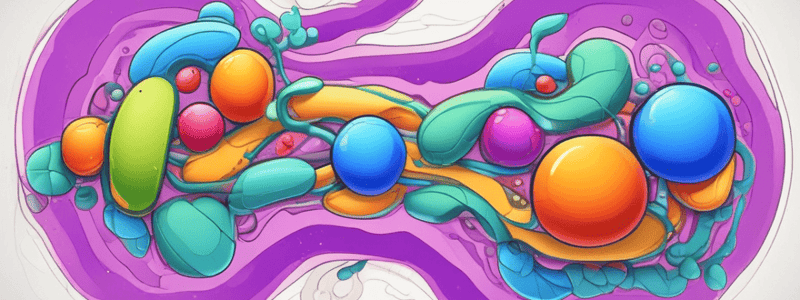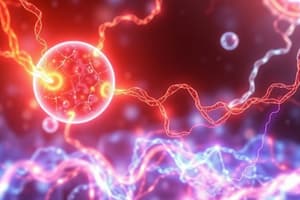Podcast
Questions and Answers
What is produced to carry the electrons in the pathway?
What is produced to carry the electrons in the pathway?
- FADH2
- ATP
- ADP
- NADH (correct)
Which molecule undergoes dehydrogenation in the pathway?
Which molecule undergoes dehydrogenation in the pathway?
- FADH2
- NADH (correct)
- ADP
- ATP
What is the primary purpose of producing NADH in the pathway?
What is the primary purpose of producing NADH in the pathway?
- Carry electrons (correct)
- Generate heat
- Facilitate protein synthesis
- Store energy
Which of the following molecules is NOT involved in carrying electrons during dehydrogenation in the pathway?
Which of the following molecules is NOT involved in carrying electrons during dehydrogenation in the pathway?
In the pathway, what role does NADH play with respect to electron transportation?
In the pathway, what role does NADH play with respect to electron transportation?
What happens at this point in the process?
What happens at this point in the process?
Which structure has not yet been reformed by E2?
Which structure has not yet been reformed by E2?
What is the status of E2's original structure at this point?
What is the status of E2's original structure at this point?
Which molecule is undergoing formation in the process described?
Which molecule is undergoing formation in the process described?
What is the current state of E2's disulfide bond?
What is the current state of E2's disulfide bond?
Which enzyme is responsible for synthesizing citrate?
Which enzyme is responsible for synthesizing citrate?
Which enzyme is named after the intermediate aconitate?
Which enzyme is named after the intermediate aconitate?
Which enzyme is involved in converting isocitrate to alpha-ketoglutarate?
Which enzyme is involved in converting isocitrate to alpha-ketoglutarate?
What is the main function of malate synthase in the citric acid cycle?
What is the main function of malate synthase in the citric acid cycle?
Which enzyme is responsible for the conversion of succinate to fumarate in the citric acid cycle?
Which enzyme is responsible for the conversion of succinate to fumarate in the citric acid cycle?
What is the product of the hydration of Fumarase?
What is the product of the hydration of Fumarase?
Which enzyme oxidizes the alcohol group of malate to a keto group?
Which enzyme oxidizes the alcohol group of malate to a keto group?
What is the role of NAD+ in the reaction where malate is converted to oxaloacetate?
What is the role of NAD+ in the reaction where malate is converted to oxaloacetate?
Which molecule is produced along with NADH when malate is oxidized to oxaloacetate?
Which molecule is produced along with NADH when malate is oxidized to oxaloacetate?
What happens to the alcohol group of malate during the oxidation process?
What happens to the alcohol group of malate during the oxidation process?
What is the fate of fats in terms of metabolism, according to the text?
What is the fate of fats in terms of metabolism, according to the text?
Why is it mentioned that fat cannot be converted to glucose?
Why is it mentioned that fat cannot be converted to glucose?
What is the fate of Acetyl CoA if oxaloacetate is not present?
What is the fate of Acetyl CoA if oxaloacetate is not present?
What is the role of CoA in fat metabolism?
What is the role of CoA in fat metabolism?
Why is it essential for oxaloacetate to be present for Acetyl CoA metabolism?
Why is it essential for oxaloacetate to be present for Acetyl CoA metabolism?
What needs to be converted in succinate to a keto group?
What needs to be converted in succinate to a keto group?
Which carbon atom needs to be reformed in the middle?
Which carbon atom needs to be reformed in the middle?
What is the targeted group for conversion in the process described?
What is the targeted group for conversion in the process described?
What is the aim of reforming the carbon in the middle?
What is the aim of reforming the carbon in the middle?
In succinate, what will be the result of converting CH2–CH2 to a keto group?
In succinate, what will be the result of converting CH2–CH2 to a keto group?
What is the final electron acceptor in the electron transport chain during oxidative phosphorylation?
What is the final electron acceptor in the electron transport chain during oxidative phosphorylation?
Which process requires oxygen as a crucial component in cellular respiration?
Which process requires oxygen as a crucial component in cellular respiration?
What is the primary role of the electron transport chain in cellular respiration?
What is the primary role of the electron transport chain in cellular respiration?
Which molecule serves as an intermediate carrier of electrons in the electron transport chain?
Which molecule serves as an intermediate carrier of electrons in the electron transport chain?
What is the essential requirement for the efficient functioning of oxidative phosphorylation in mitochondria?
What is the essential requirement for the efficient functioning of oxidative phosphorylation in mitochondria?
What is the product of the eighth reaction in the pathway?
What is the product of the eighth reaction in the pathway?
Which reaction converts 5 carbon to 4 carbon in the pathway?
Which reaction converts 5 carbon to 4 carbon in the pathway?
In which reaction of the pathway does the conversion from an alkane to an alkene occur?
In which reaction of the pathway does the conversion from an alkane to an alkene occur?
What happens to Acetyl CoA if oxaloacetate is absent in the pathway?
What happens to Acetyl CoA if oxaloacetate is absent in the pathway?
Which group is formed when alcohol is converted to a ketone in the pathway?
Which group is formed when alcohol is converted to a ketone in the pathway?
What type of reaction catalyzes the final dehydrogenation in the process described?
What type of reaction catalyzes the final dehydrogenation in the process described?
In the described process, which molecule acts as the catalyst for the reaction?
In the described process, which molecule acts as the catalyst for the reaction?
What is the overall effect of oxidation in this process?
What is the overall effect of oxidation in this process?
Which type of reaction is NOT involved in the process described?
Which type of reaction is NOT involved in the process described?
What is the specific enzyme responsible for catalyzing the final dehydrogenation reaction?
What is the specific enzyme responsible for catalyzing the final dehydrogenation reaction?
Which process inhibits aconitase from converting citrate to aconitate?
Which process inhibits aconitase from converting citrate to aconitate?
What type of inhibition affects the activity of aconitase in the citric acid cycle?
What type of inhibition affects the activity of aconitase in the citric acid cycle?
What effect does fluoroacetate have on the function of aconitase in the citric acid cycle?
What effect does fluoroacetate have on the function of aconitase in the citric acid cycle?
Which compound causes noncompetitive inhibition of aconitase in the citric acid cycle?
Which compound causes noncompetitive inhibition of aconitase in the citric acid cycle?
What impact does fluoroacetate have on the conversion of citrate to aconitate by aconitase?
What impact does fluoroacetate have on the conversion of citrate to aconitate by aconitase?
What type of functional group does citrate contain that cannot be oxidized?
What type of functional group does citrate contain that cannot be oxidized?
How many carboxylic groups are present in citrate that cannot be oxidized?
How many carboxylic groups are present in citrate that cannot be oxidized?
In citrate, what is the oxidation status of the carboxylic groups?
In citrate, what is the oxidation status of the carboxylic groups?
What characteristic of the hydroxyl group in citrate makes it resistant to oxidation?
What characteristic of the hydroxyl group in citrate makes it resistant to oxidation?
Which type of functional group in citrate plays a role in its resistance to oxidation?
Which type of functional group in citrate plays a role in its resistance to oxidation?
What is the fate of the H molecule that comes out as H+ during the reaction catalyzed by isocitrate dehydrogenase?
What is the fate of the H molecule that comes out as H+ during the reaction catalyzed by isocitrate dehydrogenase?
What serves as the electron carrier in the reaction catalyzed by isocitrate dehydrogenase?
What serves as the electron carrier in the reaction catalyzed by isocitrate dehydrogenase?
Which molecule binds to the other released hydrogen atom during the reaction catalyzed by isocitrate dehydrogenase?
Which molecule binds to the other released hydrogen atom during the reaction catalyzed by isocitrate dehydrogenase?
What is the end product of the conversion of isocitrate catalyzed by isocitrate dehydrogenase?
What is the end product of the conversion of isocitrate catalyzed by isocitrate dehydrogenase?
What happens to the H- ion that is produced during the reaction catalyzed by isocitrate dehydrogenase?
What happens to the H- ion that is produced during the reaction catalyzed by isocitrate dehydrogenase?
What is the most likely effect of Ca+2 on the rate-limiting enzyme isocitrate dehydrogenase?
What is the most likely effect of Ca+2 on the rate-limiting enzyme isocitrate dehydrogenase?
Which molecule is most likely to have an inhibitory effect on isocitrate dehydrogenase?
Which molecule is most likely to have an inhibitory effect on isocitrate dehydrogenase?
What is the probable impact of the absence of ADP on the regulation of isocitrate dehydrogenase?
What is the probable impact of the absence of ADP on the regulation of isocitrate dehydrogenase?
How does the presence of NADH likely affect the activity of isocitrate dehydrogenase?
How does the presence of NADH likely affect the activity of isocitrate dehydrogenase?
Which factor is most likely to have a dual regulatory effect on isocitrate dehydrogenase?
Which factor is most likely to have a dual regulatory effect on isocitrate dehydrogenase?
Which step in the Krebs cycle is mentioned as the only irreversible one?
Which step in the Krebs cycle is mentioned as the only irreversible one?
What reaction in the Krebs cycle involves the conversion of Fumarate to Malate?
What reaction in the Krebs cycle involves the conversion of Fumarate to Malate?
Which compound is formed by converting Citrate to Isocitrate in the Krebs cycle?
Which compound is formed by converting Citrate to Isocitrate in the Krebs cycle?
In the Krebs cycle, which reaction converts Succinate to Fumarate?
In the Krebs cycle, which reaction converts Succinate to Fumarate?
Which compound is involved in the conversion from Citrate to Isocitrate in the Krebs cycle?
Which compound is involved in the conversion from Citrate to Isocitrate in the Krebs cycle?
Which type of inhibition is exhibited by fluoroacetate on aconitase in the citric acid cycle?
Which type of inhibition is exhibited by fluoroacetate on aconitase in the citric acid cycle?
What impact does fluoroacetate have on the activity of aconitase in the citric acid cycle?
What impact does fluoroacetate have on the activity of aconitase in the citric acid cycle?
What is the specific effect of fluoroacetate on the conversion process carried out by aconitase?
What is the specific effect of fluoroacetate on the conversion process carried out by aconitase?
Why does fluoroacetate inhibit aconitase through noncompetitive inhibition rather than competitive inhibition?
Why does fluoroacetate inhibit aconitase through noncompetitive inhibition rather than competitive inhibition?
What distinguishes fluoroacetate's inhibition of aconitase from competitive inhibition?
What distinguishes fluoroacetate's inhibition of aconitase from competitive inhibition?



